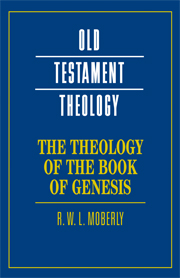Book contents
- Frontmatter
- Contents
- General Editors' Preface
- Preface
- List of Abbreviations
- 1 WHAT IS A “THEOLOGY OF GENESIS”?
- 2 ON READING GENESIS 1–11
- 3 GENESIS 1: PICTURING THE WORLD
- 4 GENESIS 2–3: ADAM AND EVE AND “THE FALL”
- 5 GENESIS 4: CAIN AND ABEL
- 6 GENESIS 6–9: CATACLYSM AND GRACE
- 7 ON READING GENESIS 12–50
- 8 GENESIS 12:1–3: A KEY TO INTERPRETING THE OLD TESTAMENT?
- 9 GENESIS 12:3A: A BIBLICAL BASIS FOR CHRISTIAN ZIONISM?
- 10 GENESIS 22: ABRAHAM – MODEL OR MONSTER?
- 11 ABRAHAM AND THE “ABRAHAMIC FAITHS”
- 12 GENESIS 37–50: IS JOSEPH WISE?
- Further Reading
- Author Index
- Scripture Index
- Subject Index
3 - GENESIS 1: PICTURING THE WORLD
Published online by Cambridge University Press: 05 June 2012
- Frontmatter
- Contents
- General Editors' Preface
- Preface
- List of Abbreviations
- 1 WHAT IS A “THEOLOGY OF GENESIS”?
- 2 ON READING GENESIS 1–11
- 3 GENESIS 1: PICTURING THE WORLD
- 4 GENESIS 2–3: ADAM AND EVE AND “THE FALL”
- 5 GENESIS 4: CAIN AND ABEL
- 6 GENESIS 6–9: CATACLYSM AND GRACE
- 7 ON READING GENESIS 12–50
- 8 GENESIS 12:1–3: A KEY TO INTERPRETING THE OLD TESTAMENT?
- 9 GENESIS 12:3A: A BIBLICAL BASIS FOR CHRISTIAN ZIONISM?
- 10 GENESIS 22: ABRAHAM – MODEL OR MONSTER?
- 11 ABRAHAM AND THE “ABRAHAMIC FAITHS”
- 12 GENESIS 37–50: IS JOSEPH WISE?
- Further Reading
- Author Index
- Scripture Index
- Subject Index
Summary
The picture of the world in Genesis 1 is sublime, and it remains so despite its detractors. Yet an account of its theological significance is as controverted as anything in the whole Bible. Handling Genesis 1 is not made any easier by the way in which many of the debates that surround it tend to bear either on particular parts of it, such as humanity in the image of God, or on particular issues whose relation to the text is in fact rather oblique, such as the nature of Jewish and Christian understandings of creation ex nihilo or the implications of modern creationism.
In order to try to maintain a focus on Genesis 1 as a whole, I propose to offer several different readings of the text – the difference each time being the context envisaged – in part because differing contexts, for both text and interpreter, bring different readings. My primary concern is to argue that the theological significance of this biblical text is inseparable from the varying ways in which it impacts on the imagination; how one pictures the world is the issue at stake. However, the way in which one pictures the world relates to the varying contexts within which that picturing is done.
A FIRST READING OF GENESIS 1
First, I offer a preliminary reading of the text “in itself.”
Initially, one overall observation. Although an impressive sequence of divine fiats – “Let there be … and it was so” – runs through Genesis 1, creation is not through fiat alone, but also substantially through fashioning.
- Type
- Chapter
- Information
- The Theology of the Book of Genesis , pp. 42 - 69Publisher: Cambridge University PressPrint publication year: 2009



